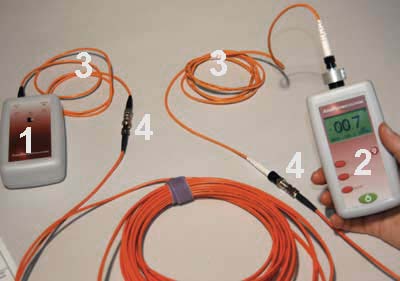The Function of Optical Fibre Testing in Ensuring High Quality and Performance in Connection Solutions
In today's rapidly developing electronic landscape, the value of optical fibre screening can not be overstated, as it serves as a keystone for making sure the quality and performance of connectivity remedies. As innovation proceeds to development, the future of optical fibre screening poses appealing challenges and chances that warrant closer assessment.
Importance of Optical Fiber Screening
The significance of optical fiber screening can not be overstated in making sure the integrity and efficiency of interaction networks. As the backbone of contemporary telecoms, optical fibers help with high-speed information transmission, making their reliability vital to functional success. Testing functions as an aggressive measure to determine potential concerns such as signal loss, depletion, and physical damages, which can compromise network performance.
Routine screening permits the confirmation of setup quality and the discovery of problems that could impact information honesty - ofda. By utilizing rigorous testing procedures, network operators can alleviate the threats linked with network failures, including downtime and monetary losses. Optical fibre testing makes certain compliance with industry requirements and guidelines, boosting the general high quality of service offered to end-users.
Eventually, the systematic assessment of optical fibres adds to the long life and effectiveness of communication systems. It allows stakeholders to make educated choices pertaining to upkeep, upgrades, and troubleshooting. In a landscape where information is progressively important, prioritizing optical fibre screening is vital to maintaining durable and efficient connectivity remedies, therefore sustaining the needs of contemporary electronic atmospheres.
Types of Optical Fiber Examinations
Numerous testing approaches are used to guarantee the functionality and integrity of optical fibers within communication networks. These tests can be generally classified into 2 primary types: installment tests and maintenance tests.
Installment tests are performed quickly after the setup of optical fibre cords to verify their performance and integrity - fibre testing equipment. The most typical setup examinations include Optical Time-Domain Reflectometry (OTDR) tests, which evaluate the top quality of the fibre by recognizing faults or breaks, and end-to-end loss examinations, which determine the total optical loss from one end of the fibre to the various other
Maintenance tests, on the other hand, are performed regularly to ensure ongoing performance and detect possible issues gradually. These include aesthetic inspection, which look for physical problems or improper setups, and connection tests, which verify that the signal can travel through the fiber without disruption.
In addition, progressed examinations such as Polarization Setting Diffusion (PMD) and Chromatic Dispersion (CD) tests can be performed to review the fiber's efficiency under different problems. By utilizing these varied testing methods, service technicians can preserve high criteria of top quality and integrity in optical fiber networks.
Benefits of Normal Evaluating
Routine testing of optical fibres plays an important role in maintaining the overall efficiency and integrity of interaction networks. By carrying out normal evaluations, companies can guarantee that their fiber optic installations satisfy sector requirements and operate successfully. This positive method assists to determine possible weaknesses and deterioration with time, permitting for prompt interventions before concerns escalate.

Cost-effectiveness is an additional advantage. By addressing minor issues early, companies can stay clear of the high prices related to major repair work or system failings. Routine testing also promotes compliance with regulatory needs, ensuring that the network follows required security and efficiency standards.
Common Concerns Recognized
Determining typical problems in optical fibre networks is necessary for keeping ideal efficiency and reliability. Different variables can add to interruptions, consisting of physical damage, bad installment click site techniques, and environmental influences.
Physical damages, such as bends, breaks, or abrasions, can considerably break down signal top quality. Improper installation methods, consisting of excessive tension or insufficient safeguarding of cables, may lead to enhanced depletion and loss of connectivity. In addition, ecological aspects such as temperature level fluctuations, wetness access, and rodent disturbance can compromise the integrity of the fibre.
Adapter problems additionally often emerge, with inappropriate alignment or contamination leading to boosted insertion loss. Moreover, splicing errors can introduce considerable signal degradation if not executed with accuracy.

Addressing these usual issues with routine optical fibre testing not only enhances network reliability but additionally enhances total performance, making sure that connection options stay robust and reliable.
Future Fads in Testing
As the need for high-speed connectivity remains to climb, the future of optical fibre screening will progressively concentrate on automation and progressed analytics. The assimilation of expert system (AI) and device learning (ML) in screening procedures will make it possible for much more reliable data evaluation and anticipating maintenance, decreasing downtime and enhancing total network integrity. Automated testing options will streamline the examination and qualification of fiber networks, reducing human mistake and raising testing throughput.
One more considerable pattern is the here fostering of remote testing modern technologies. As the deployment of fibre networks increases into remote and underserved areas, remote screening capabilities will enable professionals to monitor and identify network problems without physical visibility, thus minimizing operational costs and enhancing reaction times.
Furthermore, there will certainly be a shift towards even more extensive testing criteria that encompass not only conventional loss dimensions but additionally efficiency metrics such as latency and transmission capacity utilization. This holistic method will promote much better network monitoring and optimization techniques.
As these fads develop, the optical fibre testing landscape will certainly not only improve the quality and efficiency of connectivity services however additionally support the growing complexities of modern communication networks.
Conclusion
To conclude, optical fiber screening works as an essential part in preserving the integrity and efficiency of communication networks. By methodically assessing various specifications via established testing techniques, potential issues are recognized and corrected, making certain optimum efficiency. The ongoing dedication to regular testing not just enhances data transmission however also lines up with industry standards, promoting dependability in network facilities. As technology advances, the importance of ingenious screening techniques will proceed to grow, further advancing connectivity options.
 Luke Perry Then & Now!
Luke Perry Then & Now! Neve Campbell Then & Now!
Neve Campbell Then & Now! Nancy Kerrigan Then & Now!
Nancy Kerrigan Then & Now! Daryl Hannah Then & Now!
Daryl Hannah Then & Now! Dolly Parton Then & Now!
Dolly Parton Then & Now!